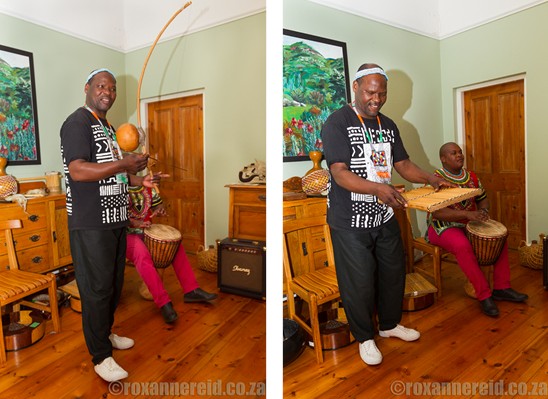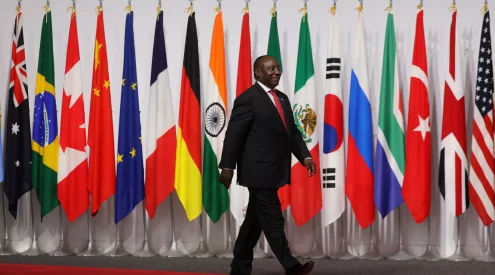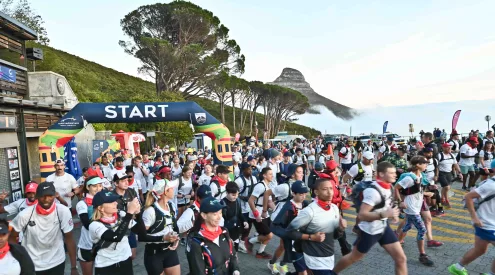The Darling Voorkamerfest is unique in South Africa. People from all walks of life open their homes to the public and various artists perform in their voorkamer (living room). This year’s performances included everything from hip hop dance, acrobatics and drama to opera and Eastern music (read more about the Voorkamerfest here).
By far my favourite show of the festival was when Dizu Plaatjies shared his love of African music. Dizu’s interest in African music has taken him all over Africa. A traditional music artist and lecturer at UCT’s Department of Ethnomusicology, he’s also the founder and former leader of Amampondo, and founder of the Ibuyambo ensemble.
He and Ibuyambo member Kim Masala played 10 or so hand-made instruments that are part of Dizu’s own collection. He told us a little bit about each one, making us smile with his gentle humour.

Dizu plays the uhadi (left) and the kayamba, with Kim on the djembe drum in the background
First was what’s probably the original instrument ever used in Africa, the San bow (yes, as in bow and arrow), or mrhubhe. The San play with the bow bouncing percussively off the string. Dizu also took the wooden bow in his mouth as he played – a bit like a dog would carry a stick – to act as an amplifier, and added an unexpected whistling counterpoint.
‘Now you think there are holes bored into this bow, but no, there are no holes,’ he smiled.
So how did the whistling happen? He showed us by putting his finger horizontally in his mouth and whistling around that too. ‘It’s just a matter of practice.’
A similar Xhosa bow, the uhadi, is bowed smoothly like a violin, achieving a completely different sound from the San bow. The uhadi has a gourd resonator that Dizu moved in different positions against his chest to change the tone. To me, it seemed as hard as rubbing your tummy and patting your head at the same time.
Drums are a big part of the African percussion culture so it was no surprise that they featured strongly in the presentation. A ‘talking drum’ from Nigeria, the pitch of which Dizu varied by squeezing its sides under his arm, a large double-sided igubu used by Zionists, and the hypnotic West African djembe – a drum I once enjoyed a fantastically inspiring lesson on in Zimbabwe but came away from with hands on fire.

Dizu plays the Igubu drum (left) and a Nigerian 'talking drum'
When drums didn’t provide the rhythmic backing, it came from a kayamba – a reed-covered board filled with seeds or stones that could be rattled or struck for variation.
For melodic sweetness, Dizu plucked at two different ‘thumb-pianos’ – a Zimbabwean mbira with its metal keys mounted inside a calabash made of fibreglass (for greater resonance) and a wooden Mozambican nyungwe propped up on his knee.
Finally, the wind instruments – the warm mellow sound of kudu horns, and the interlocking rhythmic patterns of reedy sweetness of the Mozambican nyanga pan pipes.
Simplest and perhaps best of all was a two-foot length of common-or-garden thin PVC pipe – a modern-day instrument available to almost anyone, no matter how poor. It was open at both ends with no other holes, yet Dizu made magical flute-like music with it. Mouths gaped in disbelief.
The importance of a music culture
Afterwards I asked Dizu how his musical journey began.
‘My grandparents and my aunts were very close to the San people in the Eastern Cape, and my father was a traditional healer, so I grew up with lots of music in the home,’ he said.
That’s just one reason why he teaches in local communities in Cape Town where he now lives, even though he has to fund this outreach himself. He knows it’s only through teaching young people that the diversity and wonder of African music culture will be kept alive.
He also believes teaching them about their musical heritage will give them a sense of pride, something to be passionate about, and get them away from violence on the streets.
‘I travel a lot overseas,’ said Dizu, ‘particularly to France and Switzerland, where the governments pay for arts workshops in their schools.’
Wouldn’t it be ironic if one day French people have to come here to teach us about our African musical heritage because similar state-supported educational programmes for the arts have been so sorely lacking in South Africa?
See some of the instruments mentioned in this blog post in action at an ibuyambo concert in Paris:
How important is our African musical heritage? Let us know in the comments below.
Roxanne is a writer, editor, blogger and incorrigible Africa addict. Read more about her travels here.


















